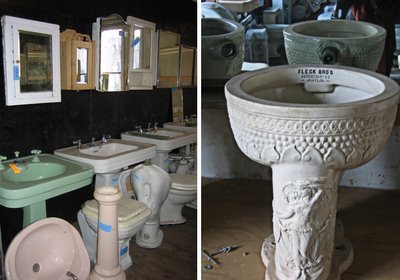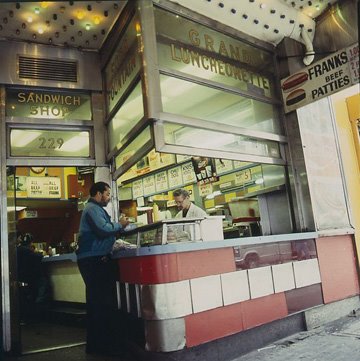skip to main |
skip to sidebar
 My friend Noel and I went up to Demolition Depot, an architectural salvage outfit on 125th and third Avenue. Four stories of remnants– many, many doors, sinks and toilets– waiting in darkness (lights are on motion detectors). All are obsessively catalogued; each item tagged with a number one looks up on a computer for a price, each entry documented with a photo. Areas on each floor are designated with small hanging signs saying things like, "swinging kitchen door section" or "full set French door section." The peculiarity of the place comes through in certain inventory choices: there may be a stunning, unusual item, say, a 4-foot tall wooden Art Deco chandelier nestled amongst rows of graceful early twentieth century oval sinks and then a small, corroded, emphatically not-special mirror, each tagged, photographed and recorded.
My friend Noel and I went up to Demolition Depot, an architectural salvage outfit on 125th and third Avenue. Four stories of remnants– many, many doors, sinks and toilets– waiting in darkness (lights are on motion detectors). All are obsessively catalogued; each item tagged with a number one looks up on a computer for a price, each entry documented with a photo. Areas on each floor are designated with small hanging signs saying things like, "swinging kitchen door section" or "full set French door section." The peculiarity of the place comes through in certain inventory choices: there may be a stunning, unusual item, say, a 4-foot tall wooden Art Deco chandelier nestled amongst rows of graceful early twentieth century oval sinks and then a small, corroded, emphatically not-special mirror, each tagged, photographed and recorded.
 All items appear to be in the exact state in which they were found and ripped from the bowels of origin. Small traces of lives remained. A door with children's stickers, another with a sad accretion of locks and chains. Toilets dressed in furry colored seat covers. Medicine cabinets with rust rings--documents of the last can or two of shaving cream?
All items appear to be in the exact state in which they were found and ripped from the bowels of origin. Small traces of lives remained. A door with children's stickers, another with a sad accretion of locks and chains. Toilets dressed in furry colored seat covers. Medicine cabinets with rust rings--documents of the last can or two of shaving cream?
We got the sense that Evan, the owner, never truly wanted to part with anything. N inquired about a large, handsome print of the Singer building propped up against the counter. It was met with "That's.... [pause]... mine. Not for sale." The small, corroded, emphatically not-special mirror mentioned above, used by us as a price gauge, was $75. To visit the fireplace annex across the street one needed to be escorted. When we asked and waited for our escort we were interrogated more than once: "Are you looking for fireplaces? Are you shopping for mantels?" Ultimately we were discouraged from venturing over, fearing what a, "just looking" might incur.
Ominously we were reminded that, if we didn't see something we wanted, we should call them since they were "always taking down buildings." Always taking down buildings. That conveyed a bit more active intent than I was comfortable with. My wistful admiration and odd sense of gratitude that someone "rescued" these items began to falter. In the Stephen King novel of Demolition Depot, Evan, sinking ever deeper into his acquisitional mania and cataloging delusions, would resort to subterfuge, landmark infringement and-- murder!--in order to take down buildings and salvage items, large and small. Then they'd remain in perpetuity on those four dark floors or "over in the warehouse."
 I love diners. They are one of the truly great things in this country. For all my anglophilia, British caffs don't even come close. They are, to be fair, fascinating in their own right but exist in a wholly different realm-- one that conjures pre-'Cool Britannia' insular Britain, resignation and strange notions of comfort food borne of privation (see: beans on toast). Perhaps I'd put them in the same continuum as the urban coffee shop but way at the other end. Very generally speaking American diners are about abundance.
I love diners. They are one of the truly great things in this country. For all my anglophilia, British caffs don't even come close. They are, to be fair, fascinating in their own right but exist in a wholly different realm-- one that conjures pre-'Cool Britannia' insular Britain, resignation and strange notions of comfort food borne of privation (see: beans on toast). Perhaps I'd put them in the same continuum as the urban coffee shop but way at the other end. Very generally speaking American diners are about abundance.
People fetishize the iconic chrome diner (one of my sentimental favorites: the Cutchogue) unfortunately to the exclusion of the many other incarnations and details of diners of all stripes. The comically grandiose Outer Borough variety (I come at this from an acutely NYC-centric perspective) in stucco and smoked mirror, are usually free-standing buildings, and are remodeled and updated periodically. You will find (9.5 times out of 10) Greek souvenir kitsch, a lively atmosphere, voluminous menus, a motorized rotating dessert display, and if you're very lucky, paper placemats of cocktail recipes that include things like Sprite. In the city, there is the corner coffee shop. It is increasingly rare to find one that retains a Hopperesque urban melancholy but I still try, having many a tuna melt around town in the process. (Andrew's Coffee Shop, Madison and 33rd, is not very Hopperesque, but it does make the best tuna melt I've encountered yet, above, the secret being the grilled toast.) Another Andrew's that closed a year or two ago on Fifth Avenue near 20th Street, was a bit closer to capturing that sensibility though not literally. Bright and beige and open-planned in a quietly 1960s way, it had an extended horseshoe counter and stools where a regular scattering of patrons was always alone together. Waitresses offered newspapers from behind the counter to those who felt stranded, not knowing what to do with themselves, or where to look, while they ate.
 A word about terminology: luncheonette, which I find to be more a written, rather than spoken, word, is a small diner: a counter with stools and maybe one row of tables or booths. Eisenberg's sandwich shop, an interesting and enigmatic hold out on Fifth Avenue, is a luncheonette. The evocatively shabby Grand Luncheonette, left, wedged under a decaying theater marquee on 42nd Street, was in fact one of the last of the dying breed of lunch counter, consisting of only the open kitchen and serving counter with stools. (Photo c. 1997 by Robert Wright.) There used to be a large Woolworth's on east 14th street that closed about the same time as the Grand and it had an iconic double-horseshoe lunch counter complete with pies on stands under glass domes. Sort of like a real-life Wayne Thiebaud.
A word about terminology: luncheonette, which I find to be more a written, rather than spoken, word, is a small diner: a counter with stools and maybe one row of tables or booths. Eisenberg's sandwich shop, an interesting and enigmatic hold out on Fifth Avenue, is a luncheonette. The evocatively shabby Grand Luncheonette, left, wedged under a decaying theater marquee on 42nd Street, was in fact one of the last of the dying breed of lunch counter, consisting of only the open kitchen and serving counter with stools. (Photo c. 1997 by Robert Wright.) There used to be a large Woolworth's on east 14th street that closed about the same time as the Grand and it had an iconic double-horseshoe lunch counter complete with pies on stands under glass domes. Sort of like a real-life Wayne Thiebaud.
I imagine New York City of the 1950s filled with lunch counters.
One of the best incarnations of all however is the random road side find--chrome or otherwise-- preferably with some mysteriously named local specialty...
 My friend Noel and I went up to Demolition Depot, an architectural salvage outfit on 125th and third Avenue. Four stories of remnants– many, many doors, sinks and toilets– waiting in darkness (lights are on motion detectors). All are obsessively catalogued; each item tagged with a number one looks up on a computer for a price, each entry documented with a photo. Areas on each floor are designated with small hanging signs saying things like, "swinging kitchen door section" or "full set French door section." The peculiarity of the place comes through in certain inventory choices: there may be a stunning, unusual item, say, a 4-foot tall wooden Art Deco chandelier nestled amongst rows of graceful early twentieth century oval sinks and then a small, corroded, emphatically not-special mirror, each tagged, photographed and recorded.
My friend Noel and I went up to Demolition Depot, an architectural salvage outfit on 125th and third Avenue. Four stories of remnants– many, many doors, sinks and toilets– waiting in darkness (lights are on motion detectors). All are obsessively catalogued; each item tagged with a number one looks up on a computer for a price, each entry documented with a photo. Areas on each floor are designated with small hanging signs saying things like, "swinging kitchen door section" or "full set French door section." The peculiarity of the place comes through in certain inventory choices: there may be a stunning, unusual item, say, a 4-foot tall wooden Art Deco chandelier nestled amongst rows of graceful early twentieth century oval sinks and then a small, corroded, emphatically not-special mirror, each tagged, photographed and recorded. All items appear to be in the exact state in which they were found and ripped from the bowels of origin. Small traces of lives remained. A door with children's stickers, another with a sad accretion of locks and chains. Toilets dressed in furry colored seat covers. Medicine cabinets with rust rings--documents of the last can or two of shaving cream?
All items appear to be in the exact state in which they were found and ripped from the bowels of origin. Small traces of lives remained. A door with children's stickers, another with a sad accretion of locks and chains. Toilets dressed in furry colored seat covers. Medicine cabinets with rust rings--documents of the last can or two of shaving cream?





